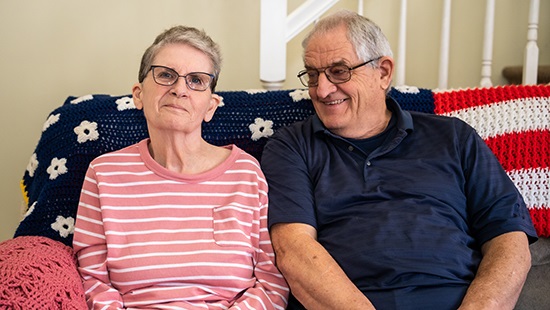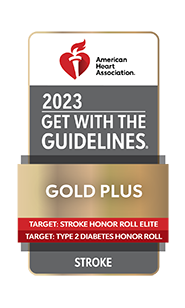The Right Place at the Right Time

Faye Kiessling, a retired hospital unit secretary and retail shift supervisor, and Lawrence, a retired county maintenance superintendent, had been preparing for a routine doctor visit and some errands. Yet, something was off.
"I woke up that morning and didn't feel like myself," Kiessling said. "It kind of scared me. I didn't have any pain, but I walked back in the bedroom and told Lawrence, 'I don't feel right.'"
Within minutes, Lawrence witnessed his wife's speech slurring and her lip drooping on one side. She then fell to her left side on the bed. Having learned the signs of a stroke, he recognized Kiessling's symptoms. Without hesitation, he called 911.
The ambulance arrived quickly and transported Kiessling to UM BWMC. By the time they arrived, she was unconscious and unresponsive.
Making the Decision
Meanwhile, at the hospital, Clifford Solomon, MD, received word of Kiessling's arrival. Dr. Solomon is a neurosurgeon and the director of the Spine and Neuroscience Center at UM BWMC and clinical assistant professor of neurosurgery at University of Maryland School of Medicine. He and two other members of the neurosurgery team, physician assistants Megan Bell, PA-C, and Marla Muha, PA-C, rushed to the emergency room (ER).
Kiessling had experienced a catastrophic intracerebral hemorrhagic stroke caused by a cavernoma, a severe bleed in the brain caused by a tumor-like ball of weak blood vessels that burst open.
Cavernomas are extremely rare, and most do not cause a stroke. But in Kiessling's case, the bleeding was severe. The only treatment option was surgery to stop the bleeding and remove the blood clot, even though there was a strong possibility she would not survive.
"I felt that if we didn't try, we knew what the answer was going to be," Dr. Solomon said. "There was no way she was going to come back without surgery."
Still, the final decision to operate rested with her husband. Dr. Solomon, Bell and Muha discussed the situation with Lawrence. It was a conversation he will never forget.
"Dr. Solomon said to us, 'We can either let Mother Nature take this, or there's a procedure I could try. It's up to you,'" Lawrence said. "There wasn't a high chance of success, but he thought he could do it. I said, 'God, yes! Absolutely. Let's do it.'"
Repairing the Damage
With Lawrence's approval, the neurosurgery team sprang into action. They knew that every second counted. When it comes to a stroke, doctors say, "time is brain," meaning that every second lost could mean loss of brain function.
Dr. Solomon began making calls to ensure the operating room was ready. Bell and Muha started prepping Kiessling for surgery. They didn't even wait for assistance to take Kiessling to the operating room. Given the severity of her condition, there was no time to waste.
In the operating room, the team worked together to cut through her skull to find and remove the blood clot, which was the size of two fists. It was a delicate procedure that required precision to remove the entirety of the clot without causing another bleed.
Temporary swelling is common after brain surgery, and neurosurgeons sometimes do not immediately replace the entire section of the skull. Instead, neurosurgeons typically opt to preserve it in the patient's own body. The team performed a safe technique in which they inserted a small piece of Kiessling's skull into her abdomen, allowing it to be maintained in a sterile environment with good blood flow until the swelling subsided in her brain and the skull fragment could be safely put back in place.
"A situation like this is a great example of the best UM BWMC has to offer," Dr. Solomon said. "I think we're living proof of what can be done when everybody stops what they were doing and tries to help."
The Road to Recovery
Lawrence waited as patiently as possible. He knew the risks but remained optimistic.
"Dr. Solomon told me it'd be about an hour," Lawrence said. "Even after two and a half hours went by, I knew she'd be okay. When Dr. Solomon came out and said she was okay, I could see he was just as happy as I was."
Kiessling was moved from the operating room at UM BWMC to a neurology-specific intensive care unit at Johns Hopkins Hospital. Against all odds, she woke up and began speaking within days. After a few weeks, Kiessling moved to an inpatient rehabilitation unit where she received occupational, physical and speech therapy. Dr. Solomon continued to check on her progress and was thrilled to hear of her continued improvements. On Oct. 8, 2022, about six weeks after her stroke, Kiessling was discharged home.
"Faye's progress is pretty remarkable," Dr. Solomon said. "She arrived at UM BWMC in a deep coma. She went from presenting as close to dead as humanly possible in the ER to talking, knowing who she is, following complex commands, and taking steps in physical therapy. It really is a miracle."
Less than a month after returning home, Kiessling went back into the operating room at UM BWMC on Nov. 1, 2022. The swelling in her brain had gone down, and she was ready for the skull fragment safely stored in her abdomen to be moved back to its rightful place. Dr. Solomon led the procedure that went off without a hitch.
Kiessling, too, believes her story is a miracle. She returned to the Spine and Neuroscience Center at UM BWMC two weeks later for a follow-up visit. She expected to see Bell to have the surgical staples removed from her scalp. However, Dr. Solomon walked into the exam room first. He heard Kiessling was in the office and didn't want to miss her.
"Dr. Solomon told me, 'You're my miracle,'" Kiessling shared. "I said, 'No, sir, you're my miracle.'"
In most cases, people continue to improve for about a year after a stroke. Based on Kiessling's recovery so far, Dr. Solomon expects her to continue progressing over the next few months. She continues to attend outpatient occupational and physical therapy.
"Yesterday, they had me walking in between the parallel bars," Kiessling said. "Of course, they were helping me, but the physical therapist was telling me to take a big step with my left leg and then with my right, and I was doing it."
A Future Worth Celebrating
Kiessling has always been an active person. Even in retirement, she stayed busy as an avid bowler and crocheter. She is working hard at therapy in the hopes of regaining her strength and movement in her hands so that she can crochet again.
"I will not give up," Kiessling said. "I thanked Lawrence for making all the decisions that he made, and I said, just remember our wedding vows—'til death do us part."
Though the retirement landscape looks different from what they had expected, Kiessling and her husband aren't letting the changes slow them down.
"Like Faye said—'til death do us part," Lawrence added. "We take it one day at a time. Yesterday after physical therapy, we went out to eat. We're not moping or sitting around the house."
The couple looks forward to traveling, celebrating their 50th wedding anniversary next fall and making more memories with their children and grandchildren.
"We've still got a long time to be together," Kiessling said. "We just had a little bump in the road. That's what I call it. You just have to walk over it and keep on trucking."
This story was originally published in the Spring 2023 issue of Maryland's Health Matters.

